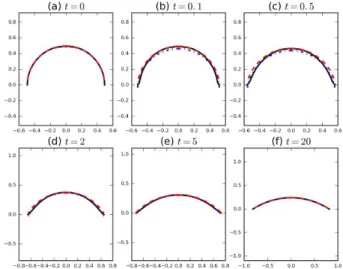HAL Id: hal-02560254
https://hal-mines-paristech.archives-ouvertes.fr/hal-02560254
Submitted on 1 May 2020HAL is a multi-disciplinary open access archive for the deposit and dissemination of sci-entific research documents, whether they are pub-lished or not. The documents may come from teaching and research institutions in France or abroad, or from public or private research centers.
L’archive ouverte pluridisciplinaire HAL, est destinée au dépôt et à la diffusion de documents scientifiques de niveau recherche, publiés ou non, émanant des établissements d’enseignement et de recherche français ou étrangers, des laboratoires publics ou privés.
Numerical investigation of wetting and phase change
phenomena to simulate boiling
Charles Brissot, Franck Pigeonneau, Elie Hachem, Rudy Valette
To cite this version:
Charles Brissot, Franck Pigeonneau, Elie Hachem, Rudy Valette. Numerical investigation of wetting and phase change phenomena to simulate boiling. Surface Wettability Effects on Phase Change Phenomena (SWEP) workshop, Jun 2019, Mons, Belgium. �hal-02560254�
Surface Wettability Effects on Phase Change Phenomena (SWEP) workshop,
6-7 June 2019, Mons, Belgium
Numerical investigation of wetting and phase change phenomena to simulate boiling
Charles Brissot, Franck Pigeonneau, Elie Hachem, Rudy Valette MINES ParisTech, PSL Research University, CEMEF – Centre for material forming CNRS UMR 7635, CS 10207, Claude Daunesse 06904 Sophia Antipolis cedex, France
Abstract
The full numerical simulation of quenching process requires tackling several phenomena: multiphase flows, fluid structure interaction and wetting, phase change, heat exchanges, etc. On the one hand, an adaptive Eulerian framework for the simulation of boiling phenomena that captures the most part is presented. However no solid-liquid contacts in parallel with boiling is allowed. On the other hand, a discontinuous Galerkin finite element method applied to the coupled unsteady Stokes/Cahn-Hilliard equations is presented. This framework provides simulations of wetting phenomena on simple cases. The opportunity to combine both frameworks for a full simulation of quenching process is discussed.
Keywords: Boiling; Multiphase Flow; Finite Elements; Wetting
Quenching processes with liquid media are complex multiphase systems. Understanding the physics of boiling behind is of high interest to predict the cooling of metal alloys. As boiling phenomena are tricky to describe, Computational Fluid Dynamics (CFD) is a good way to improve our knowledge on the flow structures in plays.
First, a framework is developed to capture multiphase flows with implicit surface tension [1]. A stabilized finite element method is coupled with a level-set method to track the gas-liquid interface. A mass transfer model is added to take into account evaporation. Thanks to an immersive volume method tackling thermic fluid solid interactions [2], numerical simulation of quenching processes are run. Results are satisfactory though the numerical scheme does not take wetting into account.
In parallel, triple line dynamics is investigated using a phase field theory. The coupled Stokes/Cahn-Hilliard equations are solved using a discontinuous Galerkin finite element method [3]. The Stokes/Cahn-Hilliard solver is tested on two problems: the capillary rising of a liquid in a tube and on the drop wetting over a horizontal solid wall (see Fig. 1). The two cases offer good results.
The aim is now to merge these two frameworks to model wetting phenomena during quenching processes. This would allow us to study the structure of fully developed nucleation and transition boiling. This would also give us a film breakage criterion, as well as some insight on the impact of external vapor influx and on vapor pocket stability. Finally, the combination of phase change and wetting which raises some numerical issues will be discussed.
Fig. 1. Drop wetting over a horizontal solid wall simulation using a Stokes/Cahn-Hilliard model discretized using a discontinuous Garlekin FEM method
[3].
REFERENCES
[1] Khalloufi, M., Mesri, Y., Valette, R., Massoni, E., Hachem, E., High fidelity anisotropic adaptive variational multiscale method for multiphase flows with surface tension, Comput. Methods Appl. Mech. Eng., 307 (2016) 44-67.
[2] Hachem, E., Digonnet, H., Massoni, E., Coupez, T., Immersed volume method for solving natural convection, conduction and radiation of a hat-shaepd disk inside a 3D enclosure, Int. J. Numer. Methods Heat Fluid Flow, 22,6 (2012) 718-741.
[3] Pigeonneau, F., Hachem, E., Saramito P., Discontinuous Galerkin finite element method applied to the couple unsteady Stokes/Cahn-Hilliard equations, Int. J. Numer. Methods Fluids, Wiley, In press, <10.1002/fld.4720>. <hal-01773404v2>.
